不纠结语法(田静)
第一章 简单句的核心
第一节 简单句的核心构成
简单句的核心导图

注意
- 主谓双宾:通常双宾语时“人+物”(to表示动作的方向,for表示动作的目的)。
例:She cooked her husband │a delicious meal.
她给丈夫煮了一顿美餐。
- 主谓宾补:“宾”和“补”之间加上“是”可构成完整句意。
例:She painted her nails red.
她把自己的指甲涂成了红色。
- 主系表:谓语无实义。
例:The weather gets hot in summer.
水在夏天变热
系动词分类:
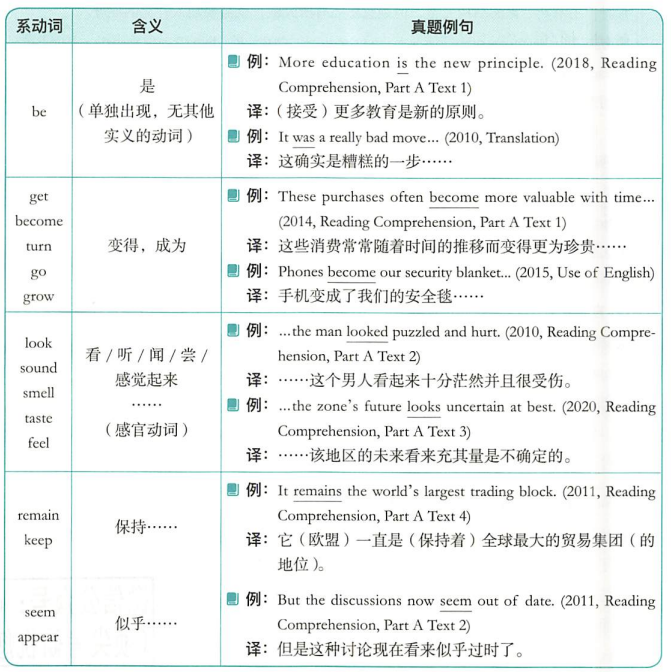
第二节 简单句的核心变化
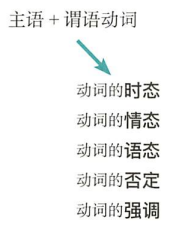
“三态一否”
一、谓语动词的变化
(一)谓语动词的时态
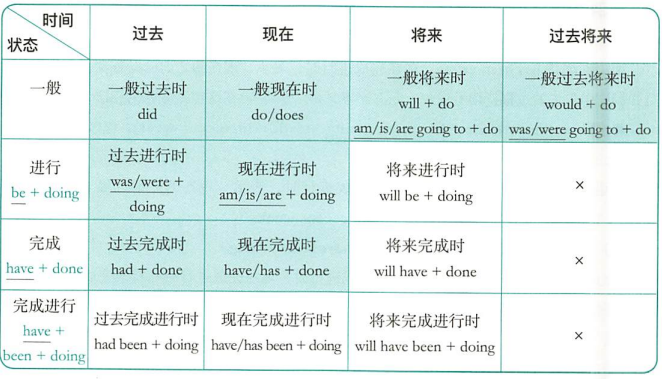
- “一般”时态(无强调,只表达事情发生在这个时间段内)
(1)一般过去时:谓语动词=did(事情发生在过去,现在已经改变)
A century ago,the immigrants from across the Atlantic included settlers and sojourners.
一个世纪前,来自大西洋彼岸的移民包括定居者和旅居者。
(2)一般现在时:谓语动词=do/does(表示现在的状态,也可以表示现在经常性、习惯性发生的事)
After bills,Tony has£60 a week to spend…
除去账单,托尼每周有60美元可以花。
(3)一般将来时:谓语动词=will do、am/is/are going to do(现在的之后)
..the future will be a wasteland of a different sort...
未来将会是一个不同种类的荒地
(4)过去将来时:谓语动词would do、was/were going to do(过去的之后)
(Facebook promised the European commission...)it would not link phone numbers to Facebook identities...
(Facebook向欧盟委员会承诺……)它不会这么做
把电话号码和Facebook的身份联系起来……
- “进行”时态(正在进行/持续进行的事)
(1)过去进行时:谓语动词=was/were+doing
…but 10 years ago he was earning£130,000 a year.…
过去那个时候他正在一年赚13万英镑
(2)现在进行时:谓语动词=am/is/are+doing
...but this era of high joblessness is probably beginning.
但是高失业率的时代现在正在开始
(3)将来进行时:谓语动词=will be+doing(将来某时正在进行,将来确定要发生的事情)
Native U.S.workers won't be returning to the farm.
美国本土的工人将来确定不会返回农场
- “完成”时态(全部完成;部分完成)
(1)过去完成时:谓语动词=had done(过去的之前)
Companies had won patents for isolated DNA for decades..
公司已经赢得分离dns的专利几十年了
Many said that unemployment...had improved them in some ways…
许多人说失业...在某些方面也提升了他们

(2)现在完成时:谓语动词=have/has done(现在的之前)
搭配:already/just/ever/never/also/nearly/long...
This "brain drain" has long bothered policymakers in poor countries.
这种“人才流失”长期以来一直困扰着贫穷国家的决策者
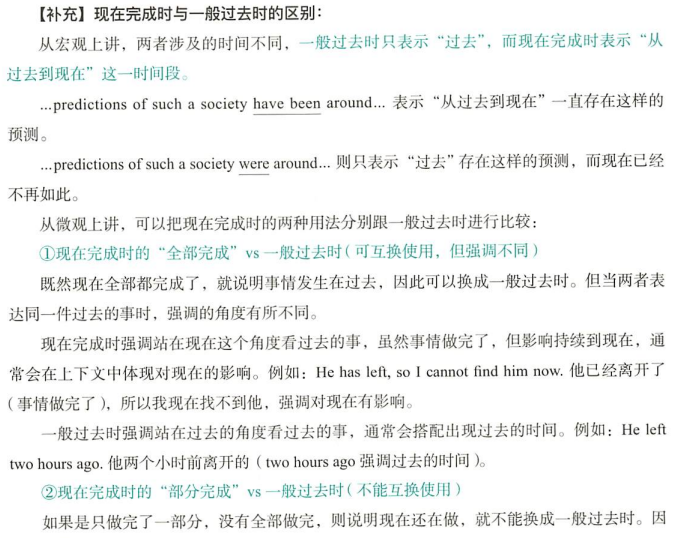

(3)将来完成时:谓语动词=will have done
we will have wasted them.
我们将已经浪费他们
- “完成进行”时态(强调一件事进行的过程)
(1)过去完成进行时:谓语动词=had been+doing
The world art market had already been losing momentum for a while after rising bewilderingly since 2003.
自从2003年的急速发展之后,世界艺术品市场失去其(原有的)势头已经有一段时间了
(2)现在完成进行时:谓语动词=have/has been doing
..the attention has been rising steadily in recent weeks.
...最近几周,关注度一直在稳步上升
(3)将来完成进行时:will have been+doing
(二)谓语动词的情态

用法:
(1)接动词原形
(2)一般只有现在和过去两种时态(表示过去;表示现在的更委婉的语气)
- 谓语动词表示”情态“
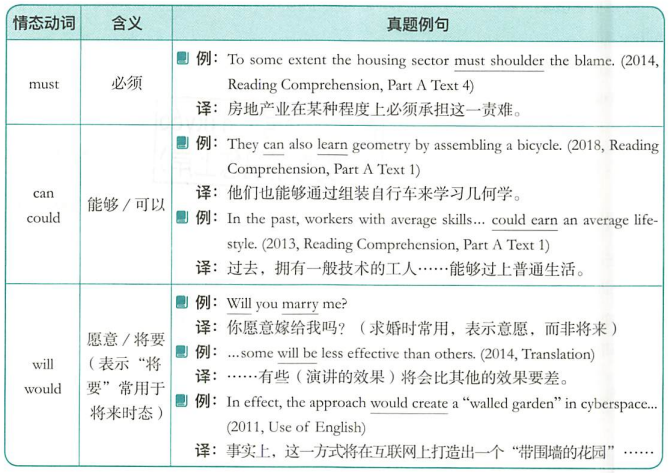
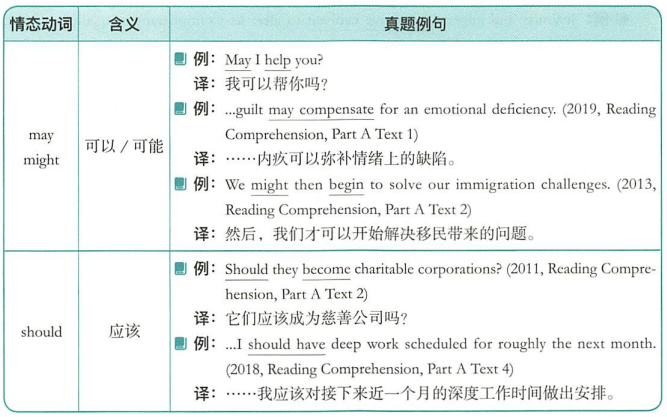
- 情态动词表示“推测”
推测的可能性:
- must:肯定,一定
- can`t/couldn`t:不可能
- 其他情态动词:可能,也许
”情态动词+do“的变体:
- 情态动词+have done:对之前的事情表达情态或推测
- 情态动词+be doing:对正在进行的事情表达情态或推测
情态动词的词组:have to(不得不,必须)/ought to(应该)
- 情态动词表示虚拟语气
(三)谓语动词的语态
语态分为两种:
- 主动语态(谓语动词的动作发出者)
- 被动语态(谓语动词的动作承受者)
- 被动语态的构成:be+done
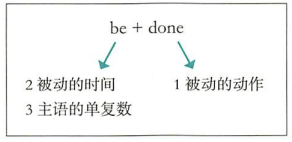
例:But her appeal was considered a failure by+动作发出者
- 被动语态与时态的结合
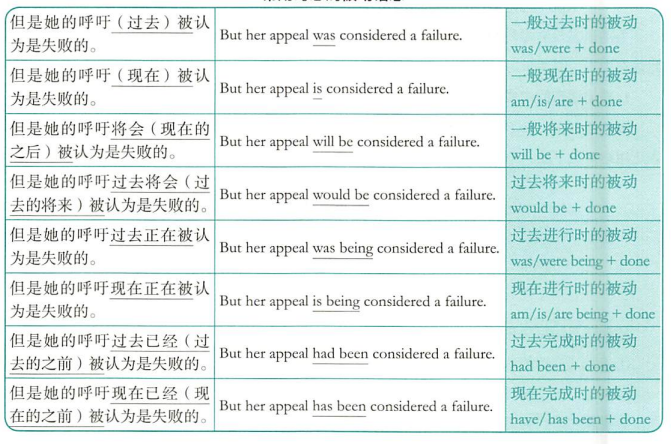
- 被动语态与情态的结合
例:Obesity...can be divided into moderately obese,severely obese,and very severely obese.(2014,Use of English)
肥胖...可以分为(能够被分为)中度肥胖、严重肥胖和极度肥胖
例:Their success may be determined by a suit...(2012,Reading Comprehension,Part A Text 3)
他们的成功可能是由一宗...诉讼案决定的
例:...sustainability-oriented values must be expressed through everyday action and choice.(2010,Translation)
...可持续性观念必须通过每日的行为和选择才能得到体现
(四)谓语动词的否态
- 实义动词变否定(do/does+not+V.原型)
例:A few decades ago,many people didn't drink water outside of a meal.(2010,Reading Comprehension,Part A Text 3)
几十年前,许多人不会在餐外时间喝水
- 助动词(be do have)和情态动词变否定(助动词和情态动词变否定直接后加not)
It has not been much fun.(2011,Reading Comprehension,Part A Text 2)
【补充】如果一个谓语动词中包含多个助动词或情态动词,否定加在第一个助动词或情态动词后。
例:I will not be waiting for you.
译:我将不会等着你。
有情态动词wil,还有助动词be,变否定要把not加在第一个情态动词will后。
(五)谓语动词的强调
强调现在:do/does+V.原型
强调过去:did+V.原型
强调将来:一般不用
例:But science does provide us with the best available guide to the future..(英语,2005,Reading Comprehension,Part A Text 2)
但是科学确实为我们的未来提供了最有效的指导
二、主语、宾语、表语的变化
(一)名词、代词
名词或名词词组作主语、宾语、表语
代词(代替上下文中提过的名词)来作主语、宾语、表语
例:...they portray an idealised version of themselves.(2014,Reading Comprehension,Part A Text 2)
...他们描绘出了自己的理想化版本
代词they作主语;
``名词词组an idealised version作宾语,位于及物动词portray后; 代词themselves作介词of的宾语。`
(二)非谓语动词doing
非谓语动词的三种形式:
- doing(可作名词)
- to do(可做名词)
- done
- doing作主语
- “doing【及物动词】+sth/sb”作为主语、宾语;
- 用a./ad./pr.修饰
例:...amplifying age and sex differences became a dominant children's marketing strategy...(2012,Reading Comprehension,Part AText 2)
...放大年龄和性别差异成为儿童(用品)市场一种主要的营销策略...
- doing作宾语
- 动宾(v.及物+doing)
- 介宾(pr.+doing)
动宾:
例:I love creating...(2017,Reading Comprehension,Part B)
我热爱创造
介宾:
例:The most likely reason for departing a board was age...(2011,Reading Comprehension,Part A Text 1)
离开董事会的最可能的原因就是年龄问题
- doing作表语
不考
(三)非谓语动词to do
- to do作主语
例:...it's easy for parents to forget about their own screen use.(2017,Reading Comprehension,Part A Text 2)
...这容易导致父母忽视自己对电子设备的使用
It takes(sb.)some time to do sth.(对于某人来说)做某事是怎么样的
- to do作宾语(不能位于介词之后:介词用doing)
例:Today many people find it difficult to trust their own opinion and seek balance by gaining objectivity from external sources.(2015,Reading Comprehension,Part B)
今天,许多人发现很难去相信自己的观点,也很难通过从外部来源获得客观性来寻求平衡
- to do作表语
例:The idea is to create a federation of private online identity systems.(2011,Use of English)
这一构想是建立一个私人的网络身份系统联盟
(四)并列多个
例:Buying gifts or giving to charity is often more pleasurable than purchasing things for oneself...(2014,Reading Comprehension,Part A Text 1)
买礼品(送人)或者做慈善常常比为自己购物更快乐
a./ad./pr.短语也可以作表语:
But the policy is unclear and contradictory (2012,Reading Comprehension,Part A Text 1)
但是这一政策不是很明确,也有争议
多个名词一同做表语:
That doesn't mean lying down and becoming fooled,or letting foreign corporations run uncontrolled..(英语一,2001,Reading Comprehension,,Passage2)
这并不是说卑躬屈膝,任人愚弄,也不是对外国公司不加控制
第二章 简单句的扩展
第一节 词性角度的扩展
一、限定词
- 冠词:a、an、the
- 数词:基数词(five)、序数词(fifth)
基数词+序数词:five of fifth(1/5)
- 名词所有格(`s)
例:More than three million doses were to be made available in early October 2009…
超过三百万剂量将在2009年10月初发放
be+to+do:将要做某事
二、形容词、副词
(一)形容词、副词作修饰成分
- 形容词修饰名词
例:...renewable energy is already a principal energy source.(2018,Reading Comprehension,Part A Text 2)
可再生能源已经是主要的能源(来源)
- 副词修饰动词、句子、形容词或其他的副词
(1)副词修饰动词
例:This temporarily lowers carbon-carrying capacity.(2019,Reading Comprehension,Part A Text 2)
这个暂时降低了碳承载能力
(2)副词修饰句子
例:Unfortunately,people create inner barriers with a help of exaggerating fears.(2015,Reading Comprehension,Part B)
不幸的是,人们在夸大恐惧的帮助下制造了内在的障碍
(3)副词修饰形容词或其他的副词
例:...those with degrees from elite universities catch up fairly quickly...(2012,Reading Comprehension,Part A Text 4)
...来自名牌大学的毕业生可以非常快地赶上...
(二)形容词、副词的三种比较级别
- 原级比较
- as+adj/adv【原型】+as+比较的对象
- “和。。。相比一样的。。。”
例:The supermarket is designed to lure customers into spending as much time as possible within its doors.(2016,Translation)
超市被设计成去诱使顾客花尽可能多的时间待在店内
- 比较级
- adj/adv的比较级(+than+比较的对象)
- “(和…相比)更…”(用于两者之间的比较)
例:..machines can perform much better at than human beings.(2014,Reading Comprehension,Part A Text 3)
...机器比人类表现得好得多(在这些工作上)
- 最高级
- the+adj/adv的最高级(+比较的对象,通常用介词短语表示范围)
- 表示“(…范围内)最…”,通常用于三者或以上的比较
例:The most immediate changes will be observed in skill level,strength and inches lost.(2019,Use of English)
最直接的变化将体现在技能水平、力量和减少的(身体)维度上
三、介词短语【crucial】
- 介词+名词/代词/doing=个词词组(介宾短语)
- 通常是句子的非核心内容
- 表示时间的介词
| 介词 | 表达含义 |
|---|---|
| at/on/in | 在。。。时间点/时间上/时间内 |
| before/after | 在。。。时间之前/之后 |
| from,since | 自从。。。时间 |
| by,until | 截止到(直到)。。。时间 |
| for | 持续。。。时间 |
| during | 在。。。期间 |
例:For the rest of the decade she apparently managed both roles without attracting much criticism (2011,Reading Comprehension,Part A Text 1)
在这十年剩余的时间里,她在两份工作中都表现得相当好,并没有招来太多的非议
- 表示地点或范围的介词
| 介词 | 表达含义 |
|---|---|
| at/in | 在。。。地点/在。。。里面 |
| on,above,over/under,below,neneath | 在。。。上面/下面(不需要区分细微区别) |
| in front of/behind | 在。。。之前/之后 |
| near/by,beside,next to | 在。。。附近/在。。。旁边(挨着) |
| between(两者),among(三者) | 在。。。之间 |
| around | 在。。。周围 |
| into/out of | 进入。。。里面/从。。。里面出去 |
| onto/off | 到。。。上面/脱离。。。 |
| across,through/past | 穿过。。。/经过。。。 |
| along | 沿着。。。 |
| from/to,towards | 来自。。。/朝着。。。去 |
| beyond | 超出,超过(指在范围外) |
Yet the link between feeling good and spending money on others can be seen among rich and poor people.(2014,Reading Comprehension,Part A Text 1)
然而,在富人和穷人当中,会看到这样一种联系:把钱花在其他人身上会给自己带来幸福感。。。
- 其他用法的介词
| 介词 | 表达含义 |
|---|---|
| of | 。。。的。。。(表示属性) |
| about | 关于。。。 |
| with/without | 伴随着有。。。/没有。。。 |
| for | 为了。。。(表示目的) |
| for | 因为。。。(表示原因) |
| for | 对于。。。(表示对象) |
| by | 通过。。。方式或方法 |
| by | 被。。。做(被动语态+by+动作的发出者) |
| by | 相差了。。。(表示变化的差额) |
| as | 作为。。。 |
| as | 像。。。一样,如同。。。 |
| like | 像。。。一样 |
| despite,in spite of | 尽管。。。 |
例:They can also learn geometry by assembling a bicycle.(2018,Reading Comprehension,Part A Text 1)
他们还可以通过组装自行车来学习几何学
第二节 成分角度的扩展
一.非谓语动词作定语、状语
非谓语动词:
- doing-主动
- to do-目的
- done-被动-by
- 非谓语动词作定语(修饰限定名词:。。。的名词)
例:It is the first worldwide epidemic designated by the World Health Organization in 41 years.(2010,Use of English)
这是世界卫生组织41年来第一次指定的世界性流行病
- 非谓语动词作状语(修饰限定整个句子)
例:...nearly 40%of emigrants had more than a high-school education,compared with around 3.3%of all Indians over the age of 25.(2012,Translation)
。。。将近40%移居外国的人受过高中以上教育,相比之下,全印度25岁以上教育的人约占3.3%
二、同位语、插入语
(一)同位语
- 解释名词:放在名词之后(句中/句后)
例:But it was still possible to vaccinate people in other high-risk groups:health care workers,people caring for infants and healthy young people.(2010,Use of English)
但是其他高危人群接种该疫苗是可行的,如医护工作者、儿童护理人员以及健康的年轻人
- 专有名词+普通名词 / 普通名词+专有名词

- 标志性的标点:逗号,破折号,冒号
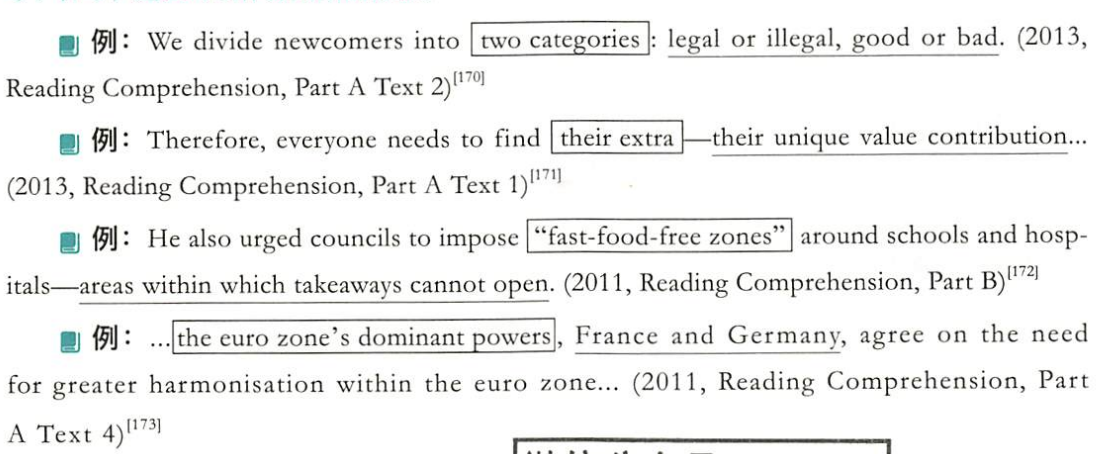
(二)插入语
- 分裂句子为两个
- 两端有成对的逗号、破折号或括号
- 主谓结构作插入语,表示“某人说,某人认为。。。”

- 副词作插入语

- 介词短语作插入语

第三章 总结
第一节 做题顺序
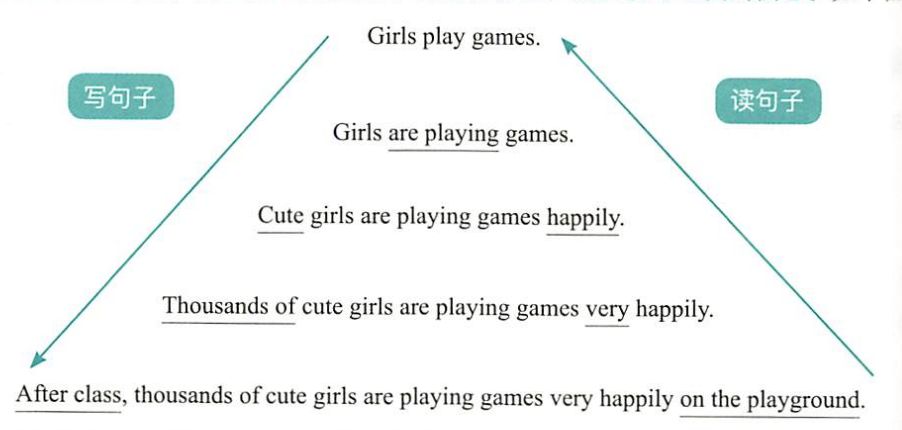
第二节 举例




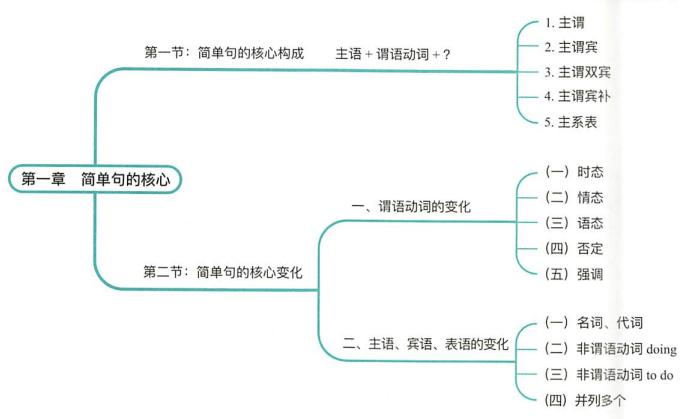 主谓双宾:通常双宾语时“人+物”
主谓双宾:通常双宾语时“人+物”
